Many employees find that a lively, open-office workplace brimming with the sounds of enthusiastic colleagues working together makes for a positive, invigorating place to collaborate on work projects. Yet others strenuously disagree; they find that unwanted office noise interferes with their ability to get productive work done. What to do? We offer eight practical tips on how to establish an office noise reduction program at your workplace that will help make your employees happier and more productive.

For many, today’s dream office has the look-and-feel of a converted warehouse loft — with an industrial look that features natural brick walls, expanses of poured concrete, open fixture lighting systems, as well as exposed pipes and ductwork. Indeed, this office look, which originated with media and tech companies, has become an established trend, as we’ve written about quite a few times. This style of workplace conveys a confident, modern (if not retro) design language that’s especially attractive to Millennials who have unique ideas about how work environments should look (hint: like a hipster coffeehouse). Managers and space planners also like the overall efficiency that these spaces provide: they hold out the promise of flexibility and collaboration-driven innovation. But there can be significant downsides if you are not careful: unless there is proper planning for acoustic comfort, these open office designs, with their hard, noise reflecting surfaces, can wreak havoc on employee satisfaction among those who find extraneous noise to be a productivity deal-breaker.
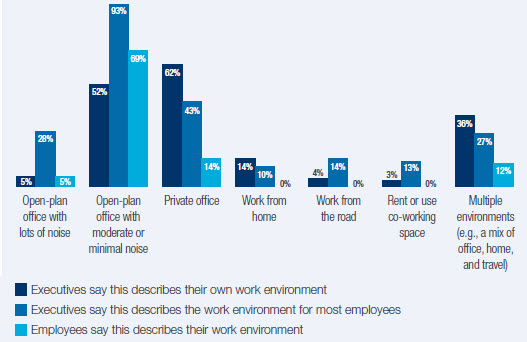
The issue of unwanted office noise hasn’t gone down quietly. More and more office acoustic “fails” are making the news.
For example, a year after the 935 million-dollar Francis Crick Institute opened in King’s Cross, London, it’s been widely reported that many of the institute’s 1,200 plus scientific researchers and office staff complain that the workplace is simply too noisy for them to concentrate effectively on their research and writing tasks.
Some of the programming developers at Apple have also recently expressed their dissatisfaction with a recent transition into open office spaces at Apple Park — a move that many employees feel favors a push toward noisy collaboration that comes at the expense of intense, quiet concentration.
Whether the unwanted noise situation is brought about by overhearing loud co-worker telephone calls, overly enthusiastic clickety-clack keyboarding, the incessant sounds of office equipment (especially large printers and copiers), or simply the repeated noise of doors opening and closing, it’s having an effect on many of today’s employees.
Research indicates that the most distracting type of noises in the workplace are the unwanted/unrelated conversations that you can’t help but overhear. The mind can’t help but want to tune in and make sense of conversations we can hear, even if it’s as banal as hearing about re-scheduling a babysitter for your colleague’s 10th-anniversary dinner on the evening of the second Tuesday of next month…
So it’s not surprising that a recent Oxford Economics Study found that, given a choice of perks, employees’ first choice was a quiet office environment where they could focus on work. This ranked higher than any other benefit — including some fairly expensive ones, such as free meals at the office or onsite daycare.
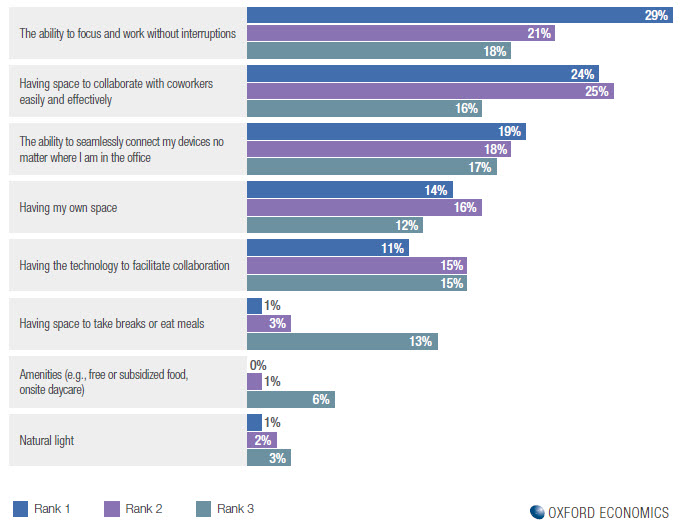
The bottom line? Managers need to get on top of this issue by implementing noisy office solutions before they face long-term issues, such as poor worker productivity, lower job satisfaction, and decreased retention rates.
How to Keep the Workplace Noise Levels in Check
Let’s look at eight practical ways you can make positive strides in office noise reduction.
1. Office Noise Reduction Starts with Careful Site Selection and Construction Details
It may be obvious, but a compromised site selection, such as one located near a busy freeway, airport, or industrial facility does not work in your favor. If noisy neighbors can’t be avoided, innovations such as modern window glazing solutions can control how much outside noise enters the building. If you are looking at leasing new office space, you’ll also want to investigate the building’s mechanical systems (such as elevators and HVAC systems) for acoustic pathways, which could introduce unwanted noise into your office space.
If you are building a new facility from scratch, you can start your office noise control program during the design and planning phase. For example, to isolate the sound of conversations between different rooms or floors, acoustic design experts can specify construction materials with enough ‘mass’ to absorb this type of noise. Low vibration noises, such as those emanating from nearby construction sites or street traffic, can be addressed by damping techniques that attenuate sound vibrations; this can be accomplished by using custom materials or applying special glue-like dampening compounds between stiff surfaces, such as drywall or plywood, to make a noise absorbing ‘sandwich.’ Because sound vibrations can travel long distances through the structure of a building, acoustic experts can also specify de-coupling ‘gaps’ in the structure that prevent sound vibrations from moving from one part of the building to another. Finally, absorption materials can be introduced in the interior, such as acoustical ceiling tiles, baffles, carpets, and engineered floors, which we’ll talk about in detail below.
2. Establishing Dedicated Loud and Quiet Zones Can Help with Office Noise Control
Creating a floor plan that supports inter-space noise control is also very important. Keep areas with noisy office equipment, such as large printers and copiers, away in isolated areas. (This can also help control unwanted indoor ozone pollution produced by these devices as well.) Other high noise areas, such as kitchen messes, cafeterias, and break rooms, also need to be acoustically isolated from work areas. Conference rooms are another obvious example of spaces that are inherently noisy. Restrooms also fall into this category, as do impromptu meeting areas and lobbies.
But what about creating other specific task zones for noisy activities within the core work areas of your office? If you dig a little deeper, there are other opportunities to create specific zones where noise generating activities take place without distracting other workers — for example, why not create convenient “telephone booths” that staff can duck into when they need to make a distracting phone call? (You may recall we highlighted some freestanding “phone booth” designs spotted earlier this year at NeoCon 2017.)
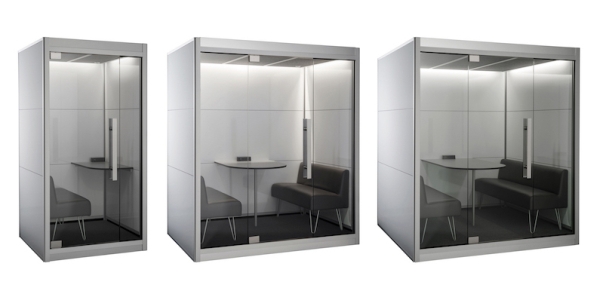
Now, let’s discuss the reverse: the need to build quiet spaces for those workers who need to concentrate with maximum attention, e.g. those working “in the zone.” Susan Cain, author of Quiet: The Power of Introverts in a World That Can’t Stop Talking, promotes the idea that many of us “introverts” have to have quiet spaces to work in order to remain productive. Short of creating dedicated private offices for each of these employees (which may not be possible in your budget), one possible solution is to provide quiet hoteling spaces, which can be shared or “checked” in or out of like a hotel room.
Don’t overlook other simple solutions as well. Creating an office convention, such as signage at the entrance to a work area that indicates a request for extra quiet during a project crunch time can help maintain a productive work environment. (Some have even created a lighted sign system to do this.)
3. Customize Your Furniture to Control Noise in the Workplace
First a bit of unsettling research.
Workers in enclosed offices are the happiest. But that’s the least economical solution. What about the next best alternative, which presumably would be cubicle furniture systems with high partitions? Aren’t these looked upon more favorably than full, open desking and benching solutions?
Surprisingly, the answer is not what you may have expected. According to recent worker satisfaction studies from the University of Sydney, cubicles with high partition dividers were rated the LEAST desirable! There are several theories on why this might be the case. Often, open benching offers better natural light and window views to the outside, which are considered important to many workers. But the Sydney researchers feel the high dissatisfaction rates can also be traced back to the idea that most workers assume a high partition would provide better acoustic privacy when, in fact, they are the worst performers in many cases.
The bottom line is that it’s imperative to choose furniture that contributes to office noise reduction. For example, Formaspace offers an extensive selection of sound-deadening materials that can be incorporated into cubicle furniture as well as our open benching and desking solutions. Many other vendors also offer casual seating furniture solutions that incorporate office noise control devices, ranging from privacy panels with built-in baffles to soft upholstery fabrics that help absorb noise.
4. Ceilings Can Play a Critical Role in Noisy Office Solutions
From an aesthetics point of view, unfinished concrete or real wood ceiling panels offer the type of “authentic” look that many designers and space planners are looking for in today’s industrial-look workplaces.
Heavy concrete can also be utilized as a latent heat “battery” to keep spaces cooler in summer and warmer in winter, a design feature that’s increasingly being investigated in places like Germany, which have very strict energy usage regulations. However, as a recent German study revealed, as energy-friendly as hard concrete ceilings may be for temperature control, their ability to bounce sound around wreaks havoc on the level of acoustic comfort in offices workplaces. One common solution is to install FHUs (Free Hanging Units) and other types of baffles in the ceiling (but, as the study points out, these counteract the beneficial temperature control characteristics of bare concrete).
What to do? You may have to compromise. One attractive solution is to create FHUs made out of industrial-looking materials, such as pre-drilled hardwood or perforated metal, with sound deadening fabric panels hidden on the back side. These perforated panels (which Formaspace can custom fabricate for your application) help control office noise while still maintaining that desirable industrial look.
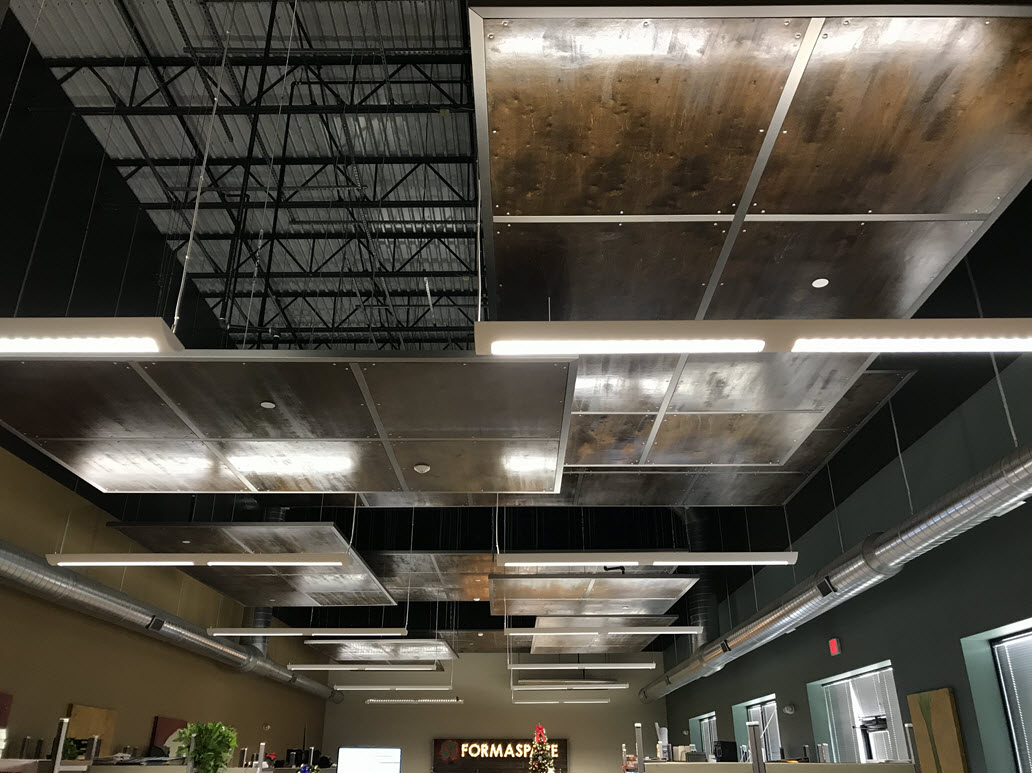
We also recommend taking a looking at a white paper published by Armstrong Ceilings to learn more about the performance of different sound control products for ceilings, including sound-deadening acoustical ceiling clouds, canopies, blades, and baffles.
5. Use Carpets and Engineered Flooring Systems for Added Office Noise Control
Carpets are useful for controlling impact noises, such as heavy footfalls from pedestrian traffic in the office. However, if you want your floors to control noise from unwanted office conversations, there is more you can do. First, you can add an additional mass element under the carpet to absorb sound. To add mass, you can choose from a range of heavy, resilient padding products, such as shredded rubber mats (which offers the heaviest mass), hard foam panels, or a cork sub-flooring material. If the carpet is installed on top of a heavy concrete floor, mission accomplished! There is sufficient mass already. (But you’ll want a pad underneath anyway to increase the lifespan of the carpet.) To achieve low vibration control, you can also install a sound dampening sub-floor under the carpet (and padding, if used).
If you want the look of hardwood or tile, but want to keep the noise down, you can install so-called engineered floating floors. As the name suggests, floating floors simply lay on top of the floor structure underneath without using fasteners, which can transmit sounds (they also maintain a small gap where they meet the walls, so sound can’t interact with the walls either).
6. Indoor Plants Can Absorb Significant Amounts of Unwanted Noise in the Workplace
We have written before about the emerging trend of using natural, or biophilic, design elements in workplace environments. Adding indoor plants to an office setting can be beneficial in many ways. Not only do many indoor plants improve the indoor air quality (See this NASA report for more information), they can help people working in the office feel more calm and relaxed. Don’t overlook the acoustic control benefits of plants either. Like carpeted floors, large office plants can help prevent sound waves from reverberating within open spaces. Not every plant will thrive inside under low light conditions. Here are four species that we can recommend:
- F
 icus Trees (Ficus benjamina) can grow quite large. The variety known as Weeping Fig has an attractive ‘drooping’ growth pattern, while other varieties are more erect and tree-like. Ficus plants produce latex compounds internally, so those who are allergic to latex products should avoid direct contact.
icus Trees (Ficus benjamina) can grow quite large. The variety known as Weeping Fig has an attractive ‘drooping’ growth pattern, while other varieties are more erect and tree-like. Ficus plants produce latex compounds internally, so those who are allergic to latex products should avoid direct contact.
 The Peace Lily (Spathiphyllum) which is also known as the Closet Plant, needs very little natural light to thrive (hence the Closet name) and may, in fact, produce yellow leaves if exposed to too much sun. These plants are especially effective at purifying the air and are easy to maintain.
The Peace Lily (Spathiphyllum) which is also known as the Closet Plant, needs very little natural light to thrive (hence the Closet name) and may, in fact, produce yellow leaves if exposed to too much sun. These plants are especially effective at purifying the air and are easy to maintain.
 Madagascan Dragon Trees (Dracaena Marginata, and others) are also commonly called Red-Edge Dracaenas. According to the NASA study, this attractive, durable plant is the top performer for reducing indoor air pollution.
Madagascan Dragon Trees (Dracaena Marginata, and others) are also commonly called Red-Edge Dracaenas. According to the NASA study, this attractive, durable plant is the top performer for reducing indoor air pollution.
 Kentia Palm (Howea forsteriana) is another plant suitable for growing in containers in the office. A South Pacific-native, Kentia Palms grow slowly but can reach 30 feet tall, making mature specimens an ideal signature plant for large open spaces.
Kentia Palm (Howea forsteriana) is another plant suitable for growing in containers in the office. A South Pacific-native, Kentia Palms grow slowly but can reach 30 feet tall, making mature specimens an ideal signature plant for large open spaces.
7. Mask the Effect of Ambient Workplace Noise with Electronic Sound Control Devices
If you can’t control noise propagation in the office by traditional acoustic control measures, today’s electronics offer new possibilities.
One technique is to introduce random, natural sounds to the workplace environment that obscure or “mask” the sound of distracting conversations. The sound of waterfalls is a popular choice for example. If you like the ambient sound of a coffeehouse, an online service called Coffitivity could be just the ticket. (Coffitivity is also available in a variety of apps.) White Noise, which sounds like random static, and its mathematically-related cousin, Pink Noise, are other popular sound masking choices used in office applications. (White and Pink Noise are also popular as sleep aids for insomniacs.) Try them out online at the Playnoise noise generator.
Sound masking solutions are also now being specified for reasons other than acoustic comfort. For example, hospitals concerned about HIPAA (Health Insurance Portability and Accountability Act of 1996) compliance are using sound masking systems to keep conversations about patient’s protected health information confidential. Industrial firms concerned about industrial espionage are using sound masking systems as well — to prevent the theft of trade secrets by outsiders snooping on conversations at the office.
8. Control Workspace Noise by Wearing Noise Canceling Headsets
No doubt you’ve encountered Millennials at the local coffee shop wearing ear-buds or full-size headsets (known today as “cans” – a slang usage which can be rather confusing to older generation workers). Indeed, the Oxford Economics study (mentioned earlier) confirms that Millennials are far and away the group most likely to bring their own acoustic noise control devices to work.
Granted, these headsets are mostly used for playing music, but increasingly, they are also incorporating Active Noise Reduction (ANR) technology, which “listens” to ambient noise and uses adaptive algorithms to create corresponding sounds with an inverted phase waveform. When these two sound waves come together, they cancel each other out, eliminating unwanted background noise.
In addition to headsets designed for listening to music, ANR systems are now standard equipment in higher-end headsets as well as speaker-phone systems used in conference rooms. Noise canceling headsets that just reduce noise are also available, and many people swear by them as an effective way to control the unwanted office noise.
ANR systems are most effective at controlling sounds that are repetitive and predictable. For example, ANR systems are now being installed as OEM equipment in passenger airplanes and cars, where engine vibrations and other noises can be measured during the development phase, and countermeasures can be programmed directly into the system.
At the moment, it’s more difficult to create a large-scale ANR system designed to keep large offices quiet due to the range of unpredictable noises — but as computer power and algorithms improve, that’s likely to come to fruition at some point. If and when these systems become available, they will become an important tool for your office noise control program.
Formaspace has the Expert Know-How to Keep Your Workspace Noise at a Healthy, Productive Level
Whether you are looking for a pure open office solution or a hybrid floor plan that incorporates semi-private cubicles, private offices, or other dedicated quiet spaces, Formaspace can help. We offer privacy panels for our full line of office desks, such as the Weldmarx II+.
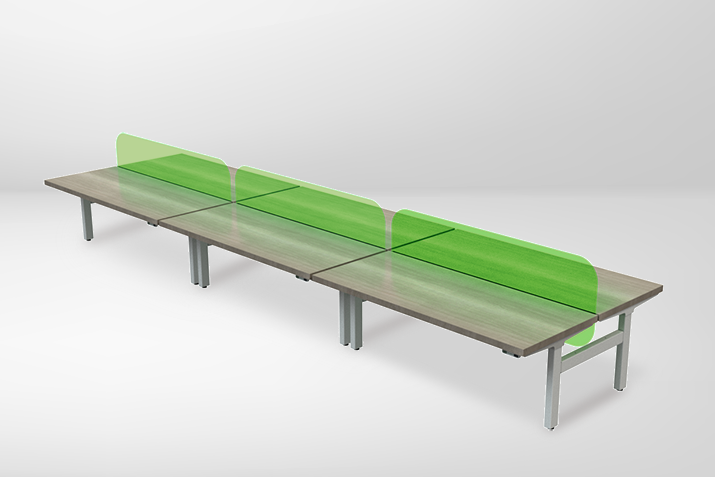
Our Formaspace Office line offers a wide range of customizable solutions, designed for your office, kitchen mess, cafeteria, or break room.
We can also build fully custom, bespoke furniture solutions just for you here at our factory headquarters in Austin, Texas — whether it’s a one-of-a-kind signature conference table made from exotic woods; a matching set of customized industrial-look, height-adjustable metal tables and desks; or hardwood ceiling panels with built-in sound deadening features.
Get the conversation started. Speak with a Formaspace Design Consultant today by filling out the quick contact form below.
This article was originally posted on formaspace.com.
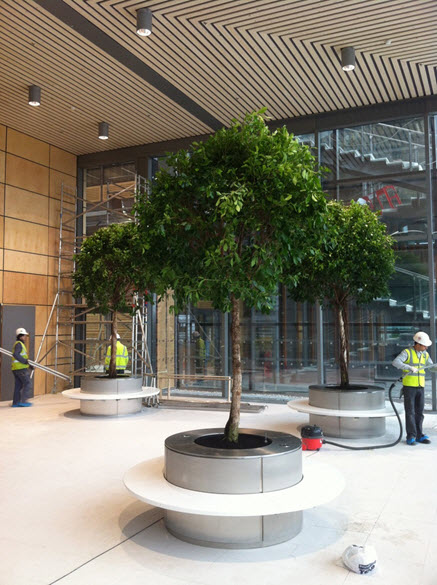 icus Trees (Ficus benjamina) can grow quite large. The variety known as Weeping Fig has an attractive ‘drooping’ growth pattern, while other varieties are more erect and tree-like. Ficus plants produce latex compounds internally, so those who are allergic to latex products should avoid direct contact.
icus Trees (Ficus benjamina) can grow quite large. The variety known as Weeping Fig has an attractive ‘drooping’ growth pattern, while other varieties are more erect and tree-like. Ficus plants produce latex compounds internally, so those who are allergic to latex products should avoid direct contact. The Peace Lily (Spathiphyllum) which is also known as the Closet Plant, needs very little natural light to thrive (hence the Closet name) and may, in fact, produce yellow leaves if exposed to too much sun. These plants are especially effective at purifying the air and are easy to maintain.
The Peace Lily (Spathiphyllum) which is also known as the Closet Plant, needs very little natural light to thrive (hence the Closet name) and may, in fact, produce yellow leaves if exposed to too much sun. These plants are especially effective at purifying the air and are easy to maintain. Madagascan Dragon Trees (Dracaena Marginata, and others) are also commonly called Red-Edge Dracaenas. According to the NASA study, this attractive, durable plant is the top performer for reducing indoor air pollution.
Madagascan Dragon Trees (Dracaena Marginata, and others) are also commonly called Red-Edge Dracaenas. According to the NASA study, this attractive, durable plant is the top performer for reducing indoor air pollution.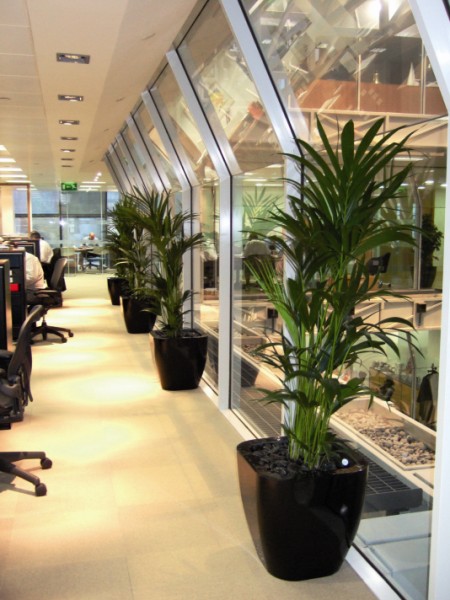 Kentia Palm (Howea forsteriana) is another plant suitable for growing in containers in the office. A South Pacific-native, Kentia Palms grow slowly but can reach 30 feet tall, making mature specimens an ideal signature plant for large open spaces.
Kentia Palm (Howea forsteriana) is another plant suitable for growing in containers in the office. A South Pacific-native, Kentia Palms grow slowly but can reach 30 feet tall, making mature specimens an ideal signature plant for large open spaces.